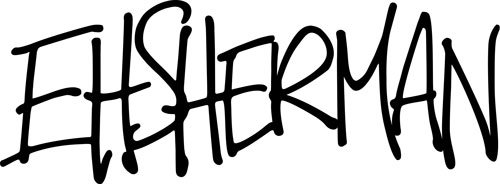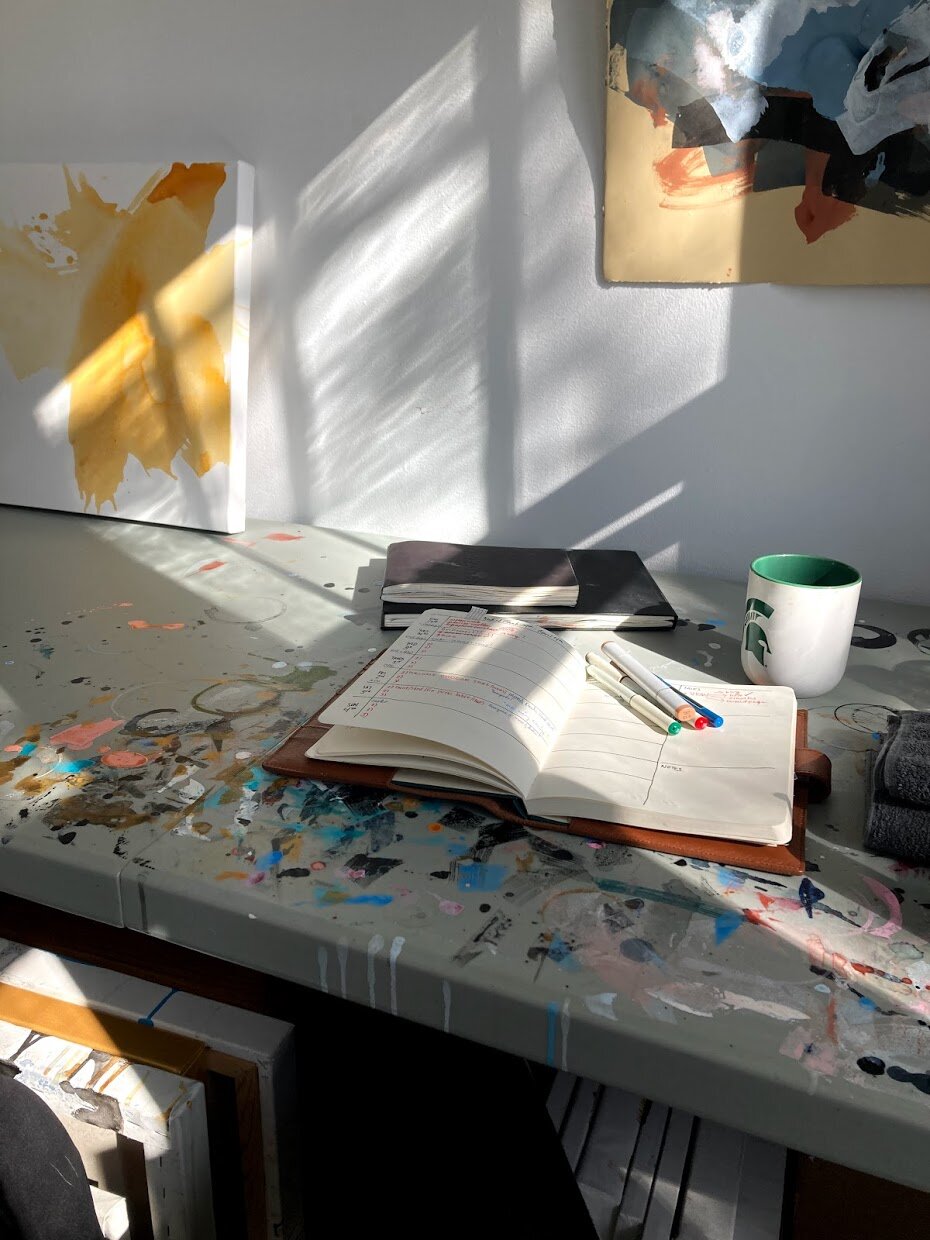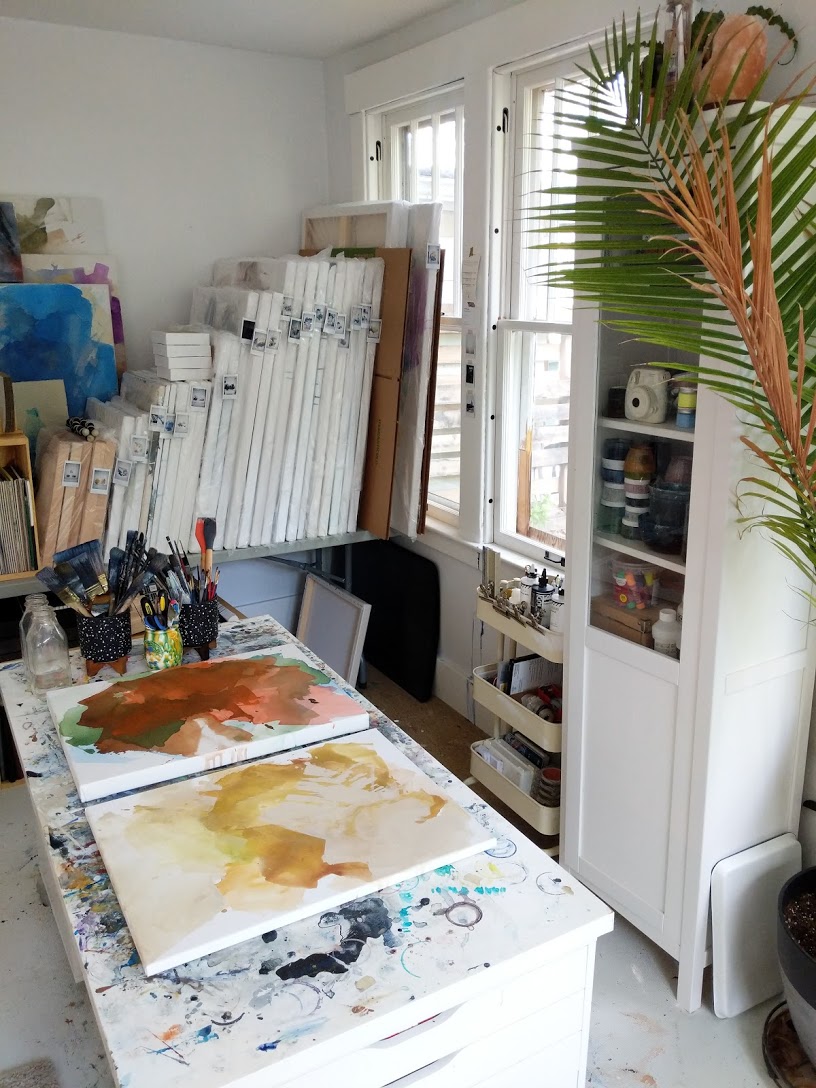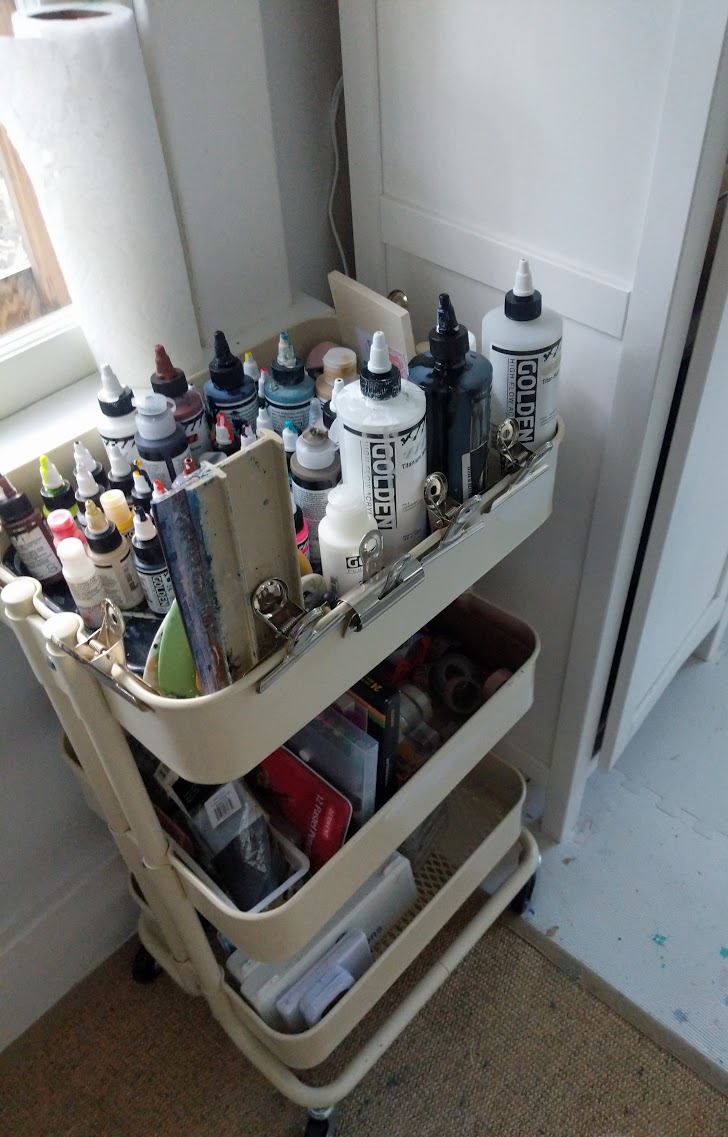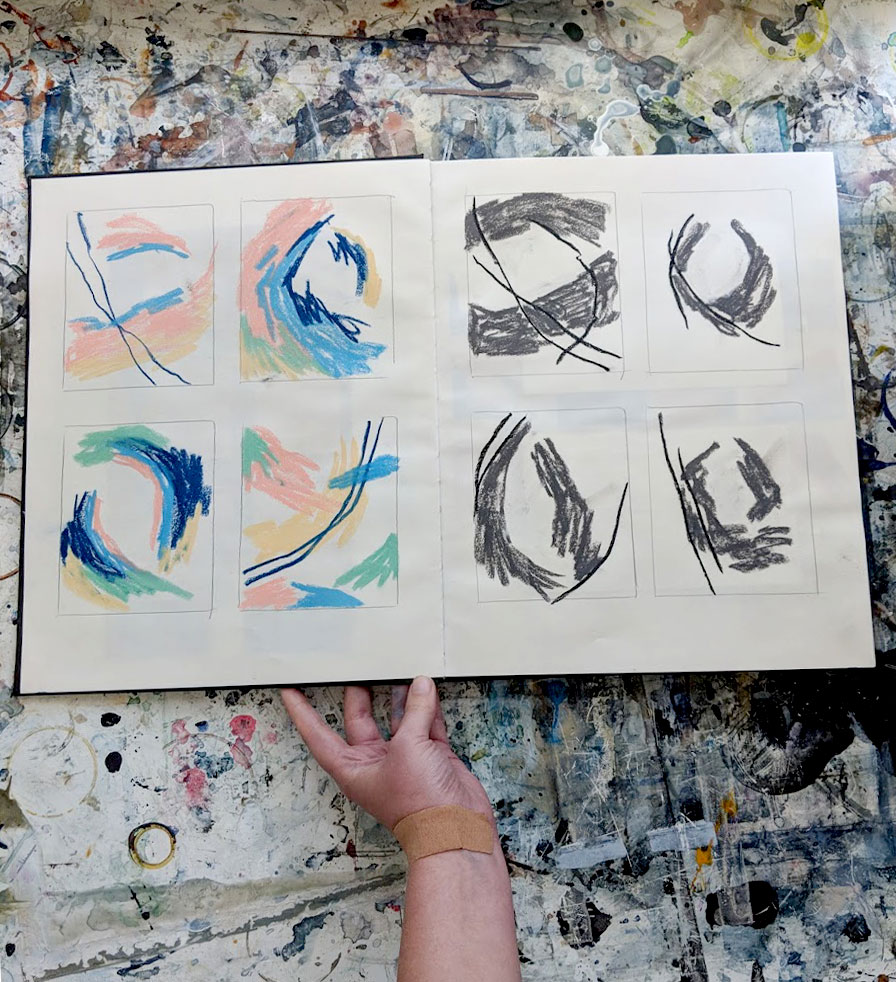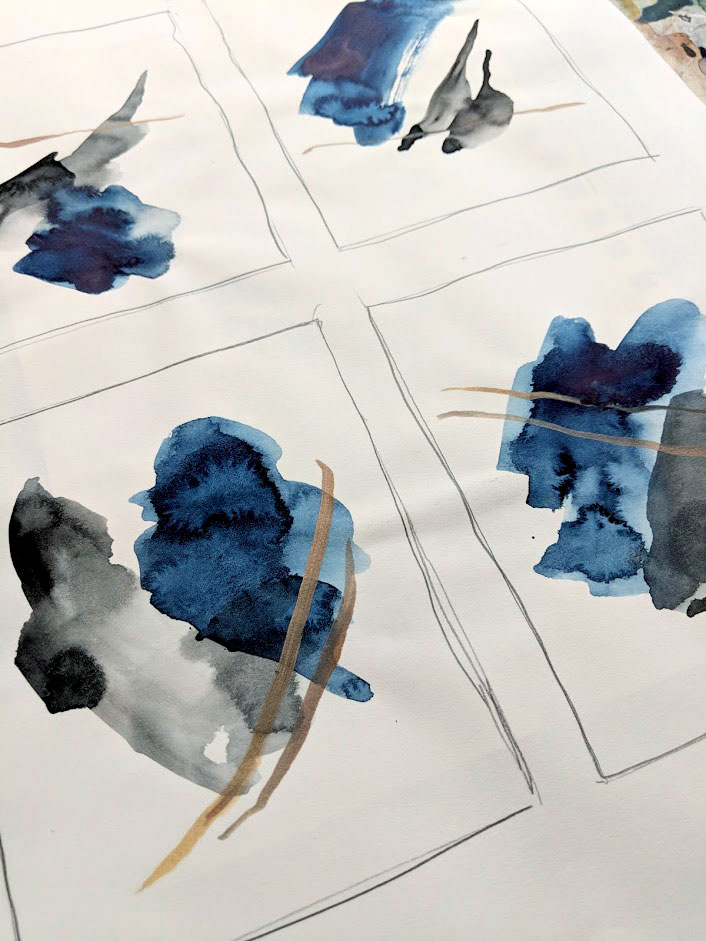Little Nonsense Scrap Notes
Birdhouses. How many layers here? Quietness. Stillness. Where is that sound? Dangling a carrot. Chasing a carrot? This looks like mud. I love mud.
It sounds like nonsense. Most of the time it is nonsense. But out of the nonsense comes a deeper understanding of what I’m doing and the words to use to describe it to others. These are extracts from the note-scraps I keep next to my pieces as I work.
I keep these note-scraps next to pieces as I work on them; I put a little paint down, think of a concept, scribble it out. Put a little more paint down, see a figure emerge from the swirling pool, name her and write it down. Layer cut pieces of paper and see a canyon - write that down.
Little scribbly clues for later.
What results is a running ‘stream of consciousness’ that serve as titles, as notes for me to refer to when describing the piece, as a marker of time. They become an invaluable addendum to the finished piece.
I do these on scrap to keep them immediate, truthful and non-precious. If I feel like I need to censor what I write to keep it organized, or legible to someone else I’m not able to get the dialogue I need to find the name of the piece or get at the inner bits of the idea I’m digging into.
Once the piece is finished, a description is written and the title fits - these little scraps head to the second drawer of my flat file. I pull them out from time to time to see if any new inspiration strikes, or if there’s an idea I wrote down that I haven’t explored yet - but for the most part their job is done.
Updating my Photobook
The last time I updated this book was before a show in summer 2019. (Thanks Covid….)
So, it’s safe to say a lot needs to be adjusted before the opening of my show on June 11th: Sold work taken out, new gallery pieces and contact info added, and of course, an updated CV.
This book comes with me to shows (space allowing) so anyone can flip through the pages and see additional work that may not have fit for the show, paintings that are currently in galleries and photos of commissions. For previous shows I had these up on a laptop/ipad, but I feel like there is something slightly more personal about leafing through an actual book. (And, on a number of occasions after the show I’d discover open tabs to people’s personal emails…. That was always an odd moment.) Archaic, analog book it is!
I use a sturdy binder with a slim profile. I love big, bold Leslie-Knope-styled binders for personal record keeping, but wanted something a tad smaller for the show setting.
I rotate out photos and info, making sure that what’s between the covers presents as a cohesive collection and not just a hodge-podge of work.
If there are fun texture moments or interesting process photos I’ll include one or two - but the emphasis is on full shots of the work in various settings. Currently I would say it’s more akin to a ‘lookbook’ rather than a ‘portfolio’. I have a website for that. (and you’re on it!)
This book (in it’s final stage!) will be with me for my upcoming solo show, Color & Contour.
The show opens on June11th at 6pm, with an RSVP-only digital preview at 530. Follow this link for more info and maybe see the book (and work…) in person!
Seasons of Work; how my work-flow has changed in the pandemic
* Note * Please, please, please, if you are able, go get vaccinated. So many people have lost so much/everything to this virus. It’s real, it’s serious and we have a way to stop it - please go get the shot(s).
Here are some resources;
It’s been interesting (at least, to me - maybe not to anyone else!) to step back and see what life in this pandemic has done to parts of my process. I can’t see all of it currently as we are still very much IN this pandemic, but patterns have slowly started to emerge.
The early pandemic days in the studio started as a frenzied mess. I was trying to make use of the extra time quarantining afforded me because if not, that extra time would be wasted and then I am a bad artist.
You can imagine how successful painting with that energy was.
(Narrator’s voice; it wasn’t.)
It took me a while to let go of the desire to harness some pandemic-residency vibe. To tell myself that we are living through some utterly weird and terrifying times and that extra time wasn’t necessarily best spent painting or other art-tasks. That I could use some time to process too.
In detaching myself from my ‘Before-Times’ schedule of brainstorming, creating, documenting, posting and shipping, all sandwiched between shows (cancelled), travel (cancelled), or other out-of-the-studio moments (severely decreased) I was able to watch a more organic, slower process start to become apparent. Less fits and starts, less following one project through each phase, more seasonal.
A season of creation.
A season of documentation.
A season of making the work public, sharing it and sending it to its new home.
Right now I’m firmly in the midst of creation. I’ve been making a lot of new things, some more successful than others, but the key is I’m making.
Instead of needing to stop to prep for a show or trip, I’m just going to ride this painting wave until my energy shifts back to the computer, to the camera and getting things ready for my website. Then onto the selling part, then to a new addition - rest and reset.
I’ve gone about two or so cycles with this pattern of making work, and thus far it’s been a welcome shift. Once life starts to get back to normal I know it will be hard to keep it - but for now I’m happy to exist in these seasons.
Studio Organization and Storage for Small Spaces
Finished!
With giving up my off-site studio earlier in the summer and a planned art space in the basement being shelved due to larger issues with the basement (one of the many exciting things about living in a 130 year old house….) the space for my art is a bit limited currently.
Previous to getting our puppy my work would simply spill out into the living room, or I would paint on the floor of the dining room if pressed for space — no big deal. Now that he is in our lives that’s both unsafe for him AND the paintings. I need everything to fit in the confines of my actual studio room and for the doors to close.
I always prefer to look at obstacles as challenges, and as someone who began working at a tiny desk, then graduating to the kitchen table - I can work with a small space. I just need to get smart about where things are located and build upwards.
After a few iterations on paper I purchased a couple of items on Amazon and started laying out my plans.
(Also a note, some of these are affiliate links - no extra charge to you if you purchase through me, but I receive a small portion of the proceeds.)
Taking pictures first!
Step One; Photographing work (for storage and display)
I start by grouping the paintings into those that still need to be photographed, and those that don’t. For photos I try to make sure I have 3 types:
A few photos on my phone. (These are for instagram and other quick sharing apps.)
A few hi res photos taken with my DSLR. ( I use these for my website and marketing materials)
One Instax photo (I take these and stick them onto the wrapped canvases. This way I know exactly where each painting is without having to dig through the stacks.)
Any excuse to use little guy. I love him.
Step Two; Protecting the Finished Paintings
I like to keep my paintings wrapped in clear plastic with reusable enclosures. This keeps out the moisture, flying paint, bugs and whatnot. (Example: Canvas Bags from Clear Bags)
Once they are wrapped up I add the instax photos to the longest side.
I’ll be stacking these upright on top of a heavy duty table, so considering where the canvas will touch other canvas is extremely important. Canvas leaning directly into canvas is a good way to dent work, so I always stack bar-to-bar or face-to-face. When sizing differs, I use sheets of cardboard to spread out the force.
See the cardboard?
To store work like small canvases, boards or paper I use these bamboo dish drying racks. It’s important to make sure the work isn’t resting on the spindles however, so if the painting is of a size that could shift and collapse inwards I don’t use these. Great for work 11 x 14 and under!
Bad! Don’t let your canvases get dented!
This is much better.
Another thing I keep by my work is a little thermometer/humidity monitor. (This is how I learned the basement wouldn’t be a suitable storage area until we handle a few other issues.) Humidity and my artwork do not mix. I’m sure in most homes and studios it’s not necessary - but we’re still learning all the fun aspects of this place so I like to have a record of the temperature and moisture content of the air.
Now that the storage area is all set - it’s time to work on the supplies!
I’m terrible at letting supplies sit out and build up and completely take over my painting surface. In my previous studio layout (painting table against the wall) the miasma of water cups and mixed paints would grow each day out from the walls like some fantastically colored mold…. which is exactly how I ended up painting in the living room.
So I Marie Kondo-ed everything in my painting cart, on my painting table and in my cabinet and ended up with a much smaller collection of materials I use daily.
( I did deviate slightly from the traditional Marie Kondo method, as I didn’t get rid of the lesser-used supplies, I just moved those into storage in the basement. I still use them, but not often enough to take up valuable studio space)
Yikes.
The Cart:
It was a disaster before, no rhyme or reason for where things were stored. When we brought home little Chewbacca I removed everything chewable from the bottom shelf and just sort of haphazardly put it on top until I could find somewhere else to keep it. It stayed there for way too long.
My new method; all heavily used paints go on the top shelf (out of reach of prying mouths), all lesser used paints go in the cabinet. The second shelf is for tape and boxes of pencils/markers/pastels, the third shelf is all of my palettes.
Everything is much more easily accessible - and puppy friendly.
I want an empty table. Well, empty-ish. Brushes, basic tools, pencils - everything I use in day-to-day can be out, but that’s it. When I had my off-site studio space I ADORED being able to walk fully around the painting area, so I wanted to keep that a function of this space.
I ditched the metal legs under the table and instead set it on top of my two flat files. By combining the furniture in the space I could open up a bit more walking room. This setup also discourages any significant cup/paint buildup as there are no walls so grow outward from. Fingers crossed it can stay this way!
So this is where my space is at currently. Even though more paintings are being stored in here I think I ended up giving myself a larger workable area, which is exciting. The early fall light is so perfect in here too, the pup can take advantage of more sunbeams!
I may look for additional storage/studio space next summer, but for now I’m really happy with my tiny studio.
Obligatory puppy tax <3
A Look into my Composition Book
The other day I posted a look into my composition sketchbook on instagram and received a few questions on the process, materials and ideas behind keeping this collection. Rather than write out paragraphs to respond there, I thought I’d take some time to explain it’s purpose a bit here.
This book cover has seen a lot of paint/chalk/pencil.
The Book:
I’m a big fan of keeping multiple sketchbooks at one time - each with a very clear and defined purpose. Color tests, travel sketches, morning sketches, still life contours, and a composition book. Keeping things separated like this allows me to reference sketches and images faster and it just appeals to the side of my personality that likes to have a space for everything, and everything in it's space.
For the Composition book I use a large sketchbook from Canson. This book serves two methods of organizing compositions;
1.) Collecting sketches from other books/cut paintings with particular compositions that I feel could use more exploration and gluing them in.
2.) Creating purely compositional study sketches on the pages.
By adhering to these two tenants I end up with a book of painting ideas divorced from color (mostly) and subject - but focused on rhythm, movement and motion.
Lines and movement.
The Why:
I use these pages to explore ideas for paintings in a pre-sketch phase. If I’ve got an idea that I want to work with, but it lacks form I open up this book and search through the studies until something clicks. If nothing does, I make however many more studies are necessary.
The Result:
Often times at first glance the final painting doesn’t look very similar to the composition work. With so many layers and lines making up the final piece the initial blocking out can be hard to spot - but if you look close enough most of the time it becomes apparent. (I say most of the time, as there are definitely cases when the final work morphs into something totally diffferent!)
Looking back on years of composition studies has been pretty enlightening as to the evolution of my process. The forms I work with are so dependent on location and my surroundings that’s it’s pretty easy to pinpoint when I moved from Miami, when I spent time in Ireland, Thailand and Japan, when we were snowed in last year and couldn’t leave for 4 days… at this point it functions almost as a journal with no words.
<3
Testing indigo/gold/gray.
Glued-In page.
Cut pieces.
